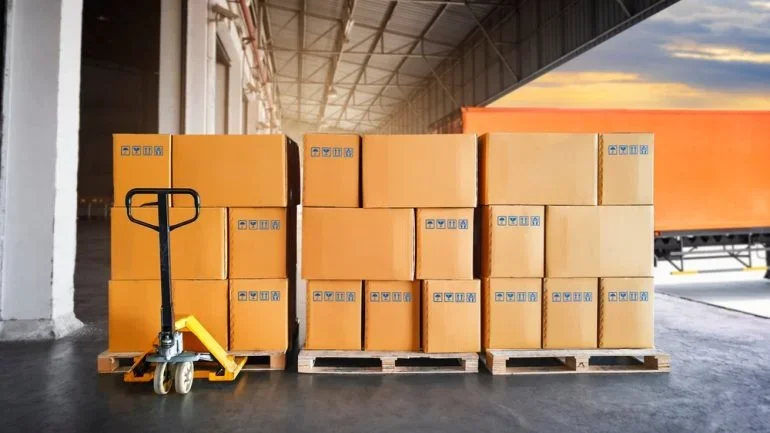With rising shipping costs and increased competition, businesses are constantly seeking efficient ways to cut expenses and streamline operations.

As companies look to enhance efficiency and reduce costs in packaging and logistics, pallet shipping has become an essential strategy. By utilising pallets to consolidate goods for shipment, businesses can improve safety, cut labour expenses, and protect products from damage.
This article explores the basics of palletised shipping, best practices for optimising cost, and methods for securely packaging goods on pallets.
Understanding the benefits of palletised shipping
Palletised shipping involves stacking products on pallets, often made from wood, plastic, or metal, to create a stable, movable unit. Using forklifts or pallet jacks, these loads are easily transported, minimising manual handling and reducing the risk of damage to individual goods.
The advantages of palletised shipping include cost savings in labour and protection from damage, but understanding how to palletise correctly is critical to maximise these benefits.
Compared to non-palletised shipping, palletised loads offer considerable logistical advantages. With non-palletised items, each piece must be handled individually, which requires more time and labour, often leading to increased costs and potential injury risks for workers.
Palletised shipping addresses these challenges, delivering not only operational efficiency but also lower labour costs, as a single forklift operator can handle an entire pallet in one go.
By reducing manual labour and the risk of damaged goods, pallet shipping offers companies a financially viable alternative to traditional non-palletised methods.
Best practices for cost-efficient palletising
To achieve cost savings with pallet shipping, it’s essential to follow best practices that secure the load while reducing wasted space. This begins with optimising load configuration—understanding the size, weight, and handling requirements of products before placing them on pallets.
Choosing the appropriate pallet type, like the widely used 48″x40″ Grocery Manufacturers Association (GMA) pallet, can simplify handling and reduce costs by standardising pallet sizes.
- Load planning and configuration: It’s important to plan the layout of the palletised load carefully. Heavier items should be placed at the bottom of the stack to create a stable base, while lighter items can go on top. For mixed or irregularly shaped loads, consider using corner protectors and stretch wrap to hold items firmly in place, preventing shifting during transit.
- Maximising space: By configuring items tightly on each pallet, companies can increase the load capacity per pallet, ultimately reducing the cost per shipped item. Tight spacing and careful stacking ensure that no room is wasted, and each pallet holds as much product as safely possible. Overloading, however, should be avoided, as it can lead to damage during transit and result in added replacement costs.
- Securing the load: Using stretch wrap or pallet straps to secure goods is essential for maintaining load integrity throughout the shipping process. Automated wrapping machines offer a consistent, quick method for securing pallet loads, saving labour time and reducing the likelihood of human error. For higher or unusually shaped loads, corner guards or additional straps may be necessary to prevent items from toppling over, ensuring the goods reach their destination in optimal condition.
Cost and safety advantages of pallet shipping
By following these best practices, companies can enjoy significant savings in transportation and packaging costs.
Palletised shipping reduces expenses by minimising product damage, lowering manual labour requirements, and allowing for streamlined transport operations.
Moreover, ensuring safety standards are met not only protects the goods but also mitigates potential injury risks for employees.
1. Reduced labour costs: Palletised loads are designed to be handled by forklifts or pallet jacks, meaning fewer workers are needed to move goods, load trucks, or unload items at the destination. In contrast, non-palletised goods often require more time and more workers, as each item must be individually handled. This labour reduction translates directly into cost savings, particularly for companies with high shipping volumes.
2. Enhanced product protection: Goods that are securely wrapped and strapped onto pallets are less likely to suffer from damage during transport, especially when the load is stacked and spaced correctly. Non-palletised goods, however, are at greater risk of being jostled around, which can lead to breakage, spills, or scratches. By decreasing the likelihood of product damage, palletised shipping reduces the need for replacement goods and lowers associated costs.
3. Optimised space and storage: Palletised loads fit well in standardised storage systems, making it easier for companies to organise their warehouse spaces. This efficient use of space reduces the need for additional storage units and cuts down on the costs associated with unused or inefficiently organised storage. When palletised correctly, goods also require less space within shipping containers, enabling companies to maximise the volume of products shipped per container and avoid the expense of additional containers.
Final thoughts on cost-effective palletised shipping
As packaging and shipping costs continue to rise, adopting palletised shipping practices allows businesses to remain competitive. Through strategic palletisation, companies can significantly reduce labour and transportation costs, optimise storage, and improve product safety.
Investing in quality pallets and wrapping equipment further enhances these benefits, offering a sustainable method for companies to ship goods reliably and economically.
By implementing best practices in palletised shipping, companies can create a cost-effective, reliable process that benefits their operations from the warehouse to the final destination.
Ultimately, using pallets efficiently offers a strong competitive advantage in today’s fast-paced logistics landscape.
Source from Packaging Gateway
Disclaimer: The information set forth above is provided by packaging-gateway.com independently of Chovm.com. Chovm.com makes no representation and warranties as to the quality and reliability of the seller and products. Chovm.com expressly disclaims any liability for breaches pertaining to the copyright of content.




